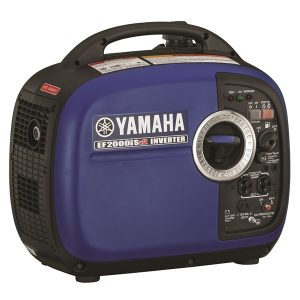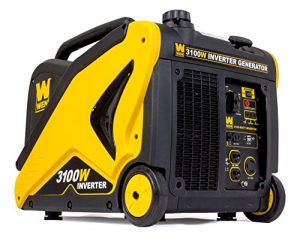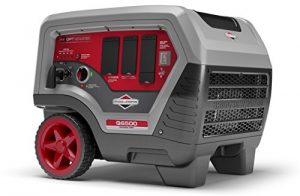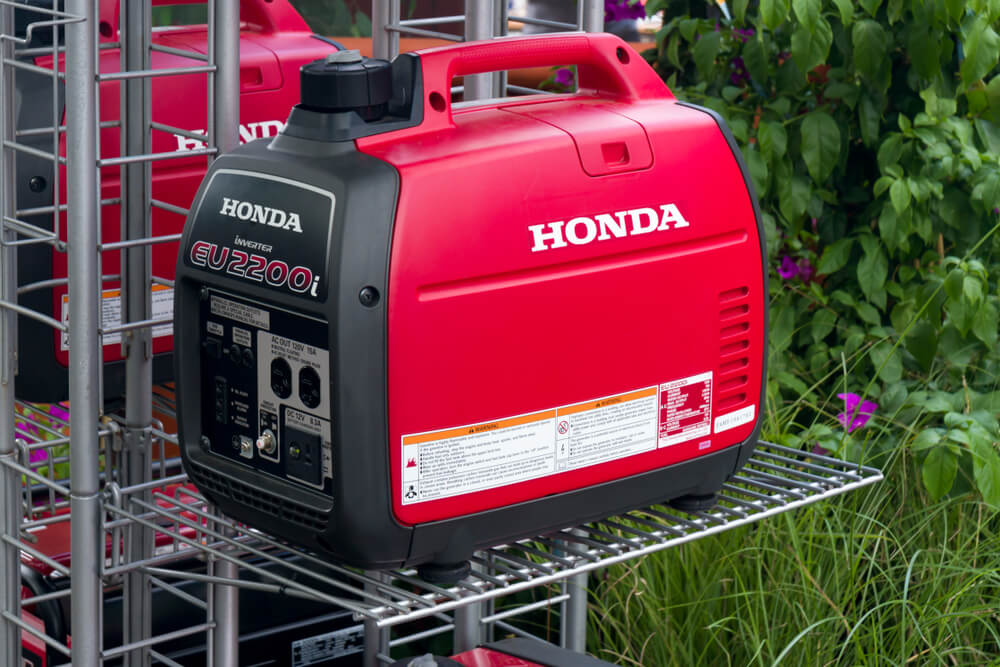Disclosure: This post may contain affiliate links. This means that at no cost to you, we may earn a small commission for qualifying purchases.
Last Updated on April 7, 2024
Inverter generators provide an energy-efficient and cost-effective alternative to regular generators.
They’re essentially a modern version of the generators of the past — complete with perks that improve safety in addition to environmental and financial concerns.
Contents
What Is an Inverter Generator?
An inverter generator gauges the needs of the appliance plugged into it. Instead of running electricity at maximum capacity, an inverter generator can adjust output as needed.
Inverter generators fit into three categories.
Recreational Generators

They’re the best inverter generators that typically weigh between 50 and 60 pounds and you can easily carry one with one hand. Due to their smaller size, recreational inverter generators only produce about 2,000 watts at most. While that won’t be enough to power a home, it’s enough for camping, boating, tailgating, hunting, and other outdoor activities.
Don’t let the small size of these generators fool you— they can still produce dangerous levels of carbon monoxide. That’s why you should never use them in enclosed spaces.
Midsize Generators

Because these larger generators weigh around 80 pounds, they come with wheels to improve portability. Midsize inverter generators produce around 2,500 to 4,500 watts of power. It is also important you look out for low oil shutoff technology generators.
That output works well for RVs with many plug-in electrical appliances, and the midsize portable generator comes in still light enough to lug around in a recreational vehicle.
Large Generators

Such inverter generators weigh 250 pounds or more. Though they have wheels, they’re too large to consider portable, which is why they tend to stay where they’re put. Take a look at our review of the top 4 Briggs & Stratton Generators
The additional weight translates into increased performance. Large inverter generators produce 5,000 watts or more of power. You can plug them into your home’s electrical panel thanks to the generator’s transfer switch — a safety device that prevents excess energy depletion.
There are two additional subtypes that exist – open- and closed-frame. Closed-frame generators have protective shells that act as noise-canceling insulation to make the portable generator quieter.
Open-frame inverter generators don’t have a protective shell. They’re louder than their closed-frame counterparts but quieter than a regular generator.
How an Inverter Generator Works
All generators use two main parts to produce energy – the engine and the alternator. Engines need fuel type like propane or gasoline to create a chemical reaction and transmit movement to a shaft.
Alternators have a rotor and a stator. The engine shaft spinning the rotor puts power in the stator. This power goes to the generator’s control panel, which then powers your appliances, home, power tools, and whatever other items you need.
The alternators of an inverter portable generator create an alternating current, or AC power, that goes to a rectifier.
This device converts the AC power into a direct current or DC power. A computer inside the portable generator converts the DC power once more into AC before the energy enters the control panel.
All of this energy flipping gives the inverter generator its name.
Inverter vs Generator: What are the Differences?
A regular generator’s alternator feeds straight to the control panel, so the energy produced from internal combustion powers whatever item plugs into it directly . There are no protective electrical devices or voltage regulators on a regular generator.
The energy produced in a regular portable generator has a high total harmonic distortion (THD) — a unit measuring how clean power is. A higher THD means less clean power.
Inverter portable generators have lower THD since they throttle energy before it enters the control panel.

Benefits of an Inverter Generator
Choosing an inverter generator makes sense for the following reasons.
Lower Fuel Consumption
Regular portable generators run at a constant energy output — usually around 3600 RPM, which is enough to deliver 120 volts of power. That much energy production requires around five gallons of gasoline.
Inverter portable generator engines don’t run at a constant level — they draw energy as needed and thus run at a slower speed. The lower energy consumption equates to lower fuel consumption, which means inverter generators also have smaller fuel tanks than regular generators.
In short, inverter generators burn less fuel compared to regular generators thanks to the slower engine speed.
Reduced Noise
Inverter generators produce less noise than a regular generator. In fact, inverter portable generators typically emit 60 decibels when they run, which is similar to the volume of two people speaking.
Regular generators produce about 90 decibels of noise — about as loud as a lawnmower.
Inverter generators sound quieter because of the slower engine speed compared to a regular generator. Inverter generator manufacturers have also prioritized noise reduction in their design. Two-thirds of inverters are portable, and consumers don’t want loud generators at a tailgate.
Portability
Compared to regular generators, manufacturers design inverter generators with portability in mind more so than regular generators. Inverter generators require less fuel than regular ones and are a viable option for powering devices on the go.
Most people can go a whole day with a filled tank of gas for the inverter generator but would need to carry extra fuel for a regular generator.
When you search for portable generators, most of the top recommendations are inverter generators.
Use with Sensitive Devices
Certain sensitive devices like smartphones, computers, tablets, and televisions, expect low THD power like the one found in your wall’s electrical outlet, a power line conditioner can actually fix this problem
You should use a small inverter generator over a regular generator when powering such sensitive devices. The high THD power from a regular generator can cause harm.
The odds of blowing out your sensitive devices with a regular generator lower as long as you’re using a generator with a low watt output.
Generators tend to have their watt output, such as 1,000 watts, 2,500 watts, and 4,000 watts, listed in its product title. There are no differences between the watt output of an inverter generator vs regular generator.
Improved Detectors, Sensors, and Alarms
Modern inverter generators have more useful features than their gas-guzzling regular counterparts. While you should never use a generator in an enclosed space, newer inverter portable generators include sensors to alert users when carbon monoxide levels reach concerning levels.
Such sensors cause the inverter to automatically shut down when carbon monoxide levels reach a certain point. The shutdown could be inconvenient if you’re powering lots of devices, but it has the overall benefit of preserving your health.
Can You Save Money With an Inverter Generator?
Yes. When comparing an inverter vs generator, inverters need less fuel to produce the same output. Because inverter generators require less fuel than regular generators, you’ll spend less money on fuel in the long run.
You could also consider the health and productivity costs of an inverter generator. A lost workday due to a carbon monoxide induced headache may not have a price, but your regained health and time translates into money saved.
What Can an Inverter Generator Power?
You can use small (50-60 pound) inverter generators for:
- Powering a television
- Operating an electric grill
- Charging power tools
- Powering a laptop
- Charging your cell phone
Midsize generators (about 80 pounds) are great for:
- Topping up a car vehicle
- Running the appliances in an RV
Use large size generators (250 pounds and up) for:
- An emergency portable power system for a home
- Running comparable electrical needs, like for two or three RVs
Inverter Generator Limitations
There are a few drawbacks to consider.
Lower Overall Energy Output
Size for size, regular generators create more power than an inverter generator. Inverter generators tend to produce around 2,000 to 4,000 watts of power. Regular generators start at 4,000 watts of power.
Unless you have a large inverter generator, your average generator won’t power heavy machinery, tools, your home, or other devices with high power requirements. That’s why inverter generators suit outdoor activities and vehicles better.
Price
The additional components that invert electrical power before it enters the control panel means that inverter generators cost a little more to build. When other perks like carbon monoxide sensors get thrown in, the price rises even further.
That’s why watt-for-watt, inverter generators tend to cost more than their regular counterpart. The smaller size and lower overall fuel consumption make up for the inverters more expensive mechanics.
Tips for Running an Inverter Generator
Here are a few things to keep in mind when using an inverter generator:
- Always run an inverter generator outdoors. Combustion from burning propane or gasoline produces toxic chemicals that can accumulate to dangerous levels in enclosed spaces.
- Run your generator at least 20 feet from where you, other people, or pets occupy space. Such distance ensures no one breathes in the harmful fumes the inverter generator produces.
- Point the inverter generator’s exhaust pipe away from where you or others situation themselves.
- Read the generator’s owner manual to know when you should perform maintenance on the machine. Maintenance includes changing the inverter’s oil, running it for a few minutes every 30 days to ensure the parts don’t wear down, and storing the generator on an empty tank should you not plan on using it for an extended period.
Conclusion
When comparing inverter generator vs regular generator, the inverter generator consumes less fuel, produces less noise, and comes in a smaller and more portable size. An inverter generator is your best bet if you need a portable option, but inverter generators can’t beat the sheer power production capability of a regular generator. You can also take a look at our comparison between Generac iq2000 vs honda eu2000i inverter generators